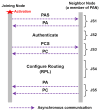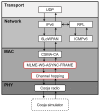Analysis of Wi-SUN FAN Network Formation Time
- PMID: 38400300
- PMCID: PMC10892317
- DOI: 10.3390/s24041142
Analysis of Wi-SUN FAN Network Formation Time
Abstract
The Wi-SUN FAN (Wireless Smart Ubiquitous Network Field Area Network) standard is attracting great interest in various applications such as smart meters, smart cities and Internet of Things (IoT) devices due to the attractive features that the standard offers, such as multihop and mesh topologies, a relatively high data rate, frequency hopping, and interoperability between manufacturers. However, the process of connecting nodes in Wi-SUN FAN networks, which includes discovering, joining, and forming the network, has been shown to be slow, especially in multihop environments, which has motivated research and experimentation to analyze this process. In the existing literature, to measure network formation time, some authors have performed experiments with up to 100 devices, which is a costly and time-consuming methodology. Others have used simulation tools that are difficult to replicate, because little information is available about the methodology used or because they are proprietary. Despite these efforts, there is still a lack of information to adequately assess the formation time of Wi-SUN FAN networks, since the experimental tests reported in the literature are expensive and time-consuming. Therefore, alternatives such as computer simulation have been explored to speed up performance analysis in different scenarios. With this perspective, this paper is focused on the implementation of the Wi-SUN FAN network formation process using the Contiki-NG open source operating system and the Cooja simultor, where a functionality was added that makes it possible to efficiently analyze the network performance, thereby facilitating the implementation of new techniques to reduce network training time. The simulation tool was integrated into Contiki-NG and has been used to estimate the network formation times in various indoor environments. The correspondence between the experimental and numerical results obtained shows that our proposal is efficient to study the formation process of this type of networks.
Keywords: Contiki-NG; Wi-SUN FAN; node connection process; simulator.
Conflict of interest statement
The authors declare no conflicts of interest.
Figures

















References
-
- IEEE Standard for Wireless Smart Utility Network Field Area Network (FAN) IEEE SA Standards Board; New York, NY, USA: 2021. pp. 1–182. - DOI
-
- Wi-SUN Alliance Secure Large-Scale IoT Networking for Today and Tomorrow. 2018. [(accessed on 15 May 2023)]. Available online: https://wi-sun.org/wp-content/uploads/Wi-SUN-Alliance-and-FAN.pdf.
-
- Landys + Gyr.TEPCO and Landis + Gyr Sign Agreement to Explore Future Options for Leveraging IoT Network. 2017. [(accessed on 22 May 2023)]. Available online: https://landisgyr.eu/news/tepco-landisgyr-sign-agreement-explore-future-...
-
- Wi-SUN Alliance What We Do. [(accessed on 22 May 2023)]. Available online: https://wi-sun.org/about.
LinkOut - more resources
Full Text Sources

